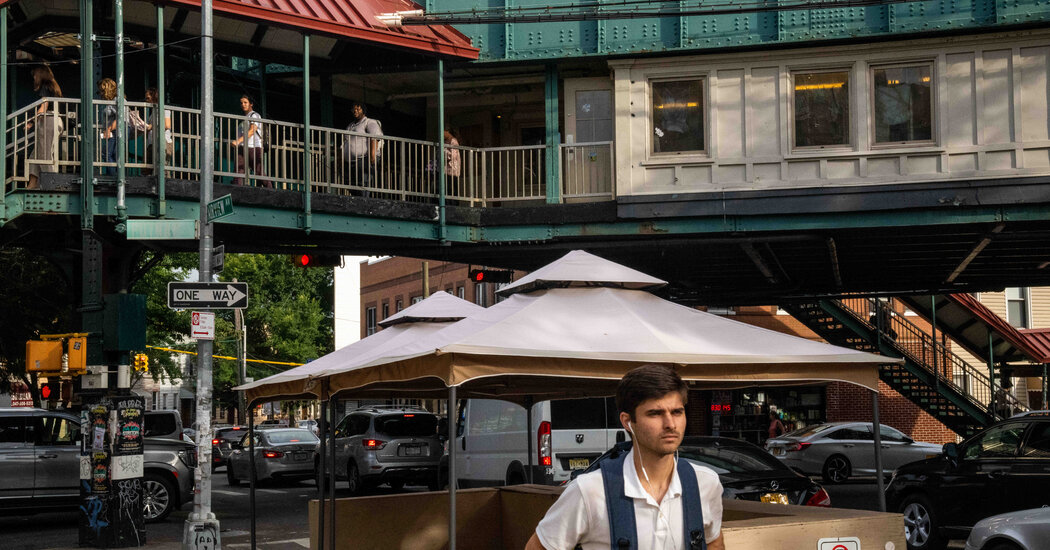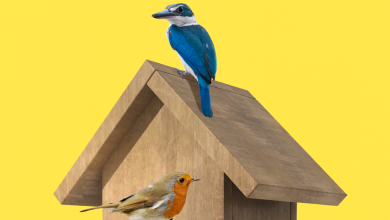Ridgewood, Queens: A Multiethnic Area That’s ‘Like a Whirlpool’

For Bikash Kharel, who runs a Nepali restaurant in Ridgewood, Queens, called While in Kathmandu, almost every night is cause for a geography lesson.
“People think we’re in Bushwick,” Mr. Kharel said about his business, which serves pleated, round dumplings and exotically spiced chicken wings, and is a full six blocks from Bushwick, the hipster haven in Brooklyn. “I have to correct them: ‘I don’t know if you realize this, but you’re in Queens, bro.’”
Mr. Kharel, 30, who was born in Nepal and came to the neighborhood when he was 13, rejects the invented words describing the geographical mash-ups in the northwest corner of Long Island. He refuses to acknowledge “Ridgebush” or “Ridgewick” or “Quooklyn.”
“This is Ridgewood, bro,” he said. “Let’s keep it clean.”
The interborough murkiness is historic, but also an effect of the 40-year-long odyssey of young creative and professional New Yorkers moving east in search of more affordable housing. Having been priced out of Williamsburg, Greenpoint and Bushwick, they are bundling into Ridgewood, planting their cafes, yoga studios and bars amid the brick architecture and mom-and-pop shops in what has long been a multiethnic working- and middle-class community.
Courtney Maginnis, 34, who designs lingerie by day and does standup comedy by night, crossed over from Bushwick four years ago. She was soon to marry another comedian, Casey James Salengo, and the couple was still sharing an apartment with a third person. “I’m not going to get married and come home to my roommate,” Ms. Maginnis said.
A real estate broker friend (yet another comedian) tipped them off to Ridgewood, where they now rent one of four units in a house at Greene and Seneca Avenues, paying $1,925 for two bedrooms. Ms. Maginnis described the apartment as “one of those New York places — no matter how much you clean it, it’s always going to look dirty,” but said she cherishes the quiet compared to her former digs. Her commute to Manhattan is about 45 minutes on the M or L train.
Rachel Weisman, who recently turned 30 and is planning a September wedding, also looked to Ridgewood for her next chapter. Ms. Weisman, an industrial designer, and her fiancé, Dan Puglisi, teamed up with Mr. Puglisi’s sister and brother-in-law to buy a building where both couples could live and maintain a family business (Enrico Puglisi Flies, a company founded by the siblings’ father, which sells fly-fishing materials).

The Stockholm Street Historic District consists of 36 matching Beaux-Arts rowhouses that were designed by Louis Berger & Company as workers’ housing for Ridgewood’s German American residents.Credit…Desiree Rios/The New York Times
“We started looking in Astoria, and also Greenpoint,” Ms. Weisman said, but could not afford the mixed-use buildings they saw there. What they found in Ridgewood “hit the mark.” The 3,800-square-foot property is near restaurants and a supermarket; the ground level is zoned for commercial use, and there are two floors above, one for each couple.
They paid $1.5 million last November, plus unforeseen thousands more to replace the roof and a collapsed pipe in the basement, where sewage was backing up. Ms. Weisman and Mr. Puglisi, who sold their condo in Douglaston, N.Y., still have to update the bathrooms in their four-bedroom unit before they can move in. But Ms. Weisman has no regrets. Their previous home was a studio.
“Ridgewood is like a whirlpool; it’s always changing,” said Herbert Morscher, a second-generation owner of Morscher’s Pork Store on Catalpa Avenue, one of the few butchers remaining in a neighborhood where there used to be dozens.
Mr. Morscher, 56, is descended from German-speaking residents of Gottschee, a region settled in the Middle Ages in what is now Slovenia. His forebears immigrated to Ridgewood in the 1950s, when it was heavily German and had a solid Gottscheer community.
He has seen them come and go, or come and stay: Austrians, Italians, Rumanians, Serbs, Poles, Mexicans, Ecuadorians, Egyptians, Puerto Ricans, South Asians. “With the young artists and college grads, they like to patronize the local guy; I respect that a lot,” he said. “They love our bacon.”
What You’ll Find
Ridgewood is a triangle bordered by East Williamsburg and Bushwick in Brooklyn, to the west and southwest, and Maspeth, Middle Village and Glendale in Queens, to the north, northeast and southeast.
The neighborhood — farm- and parkland developed as workers’ housing in the early 20th century — presents unified blocks of saffron- and buff-colored rowhouses with fetching details (bow fronts, diamond-patterned decorations, pressed-metal cornices). There are 10 historic districts, including the Central Ridgewood Historic District, which alone comprises 990 buildings and sites.
Among the designated landmarks is the circa-1709 Vander Ende-Onderdonk House on Flushing Avenue, the oldest Dutch fieldstone house in New York City and the headquarters of the Greater Ridgewood Historical Society. The house maintains a patch of lawn in a rather dystopian industrial setting at the border of East Williamsburg.
Main commercial thoroughfares include Myrtle Avenue, which runs east-west in the southern portion of the neighborhood, and Fresh Pond Road, which crosses it to the east. Seneca Avenue, extending from the northwest to the southeast, is the home of Rudy’s, a beloved German bakery that has been turning out Black Forest cake since 1934 and has been owned by the same Italian family since the early 1980s.
The gut punch of the pandemic was particularly brutal in Queens, but new restaurants have opened recently, joining the pizzerias, pho producers, Balkan grocers and Ukrainian delis. Kermit Westergaard, a developer who lives in the neighborhood, has had a hand in the opening of several, including the Mediterranean-inspired Cafe Plein Air on Forest Avenue, and Ester, a wine bar and event space in a former textile mill on Woodward Avenue.
Millers & Makers, a bakery, turned up on Woodward Avenue at the end of 2019 and is still producing its signature sweet potato cinnamon rolls.
And then there is Rolo’s. Operated by a group of chefs who previously worked at Gramercy Tavern in Manhattan, the restaurant occupies a building on Onderdonk Avenue partly owned by Mr. Westergaard. Rolo’s opened this year to respectful reviews. (The New York Times complimented the “bright, punchy flavors,” but also warned of the damages developers can inflict on modest neighborhoods with their pricey businesses: “You can have a full house and lose sight of the whole community.”)
What you won’t find in Ridgewood is much green space. Grover Cleveland Playground, which sits on a hill behind a high school, is one of the recreational patches sprinkled around. It has sports fields, a new community garden and a view of the Manhattan skyline. Rosemary’s Playground takes up a block near Ridgewood Intermediate School 93 and the Ridgewood branch of the Queens Public Library.
This being Queens, the neighborhood also has historic burial grounds that offer tranquillity, like the Linden Hill Methodist Cemetery and its conjoined Jewish neighbor. Among the people interred there are Jacob K. Javits, the four-term United States senator from New York, and David Belasco, the theatrical producer who in 1913 hired Tiffany Studios to design his family’s mausoleum.
Less than 10 minutes southeast of Ridgewood, at the Brooklyn border, is the 141-acre Highland Park, which contains the Ridgewood Reservoir and its surrounding wetlands and forests.
What You’ll Pay
As of June, the median sale price of homes in Ridgewood was $1.08 million, representing a year-over-year increase of 10.5 percent, based on 31 transactions, according to Redfin. The average time on the market for those properties was 56 days.
Seventy homes, including four single-family houses, 51 multifamily houses, six townhouses and nine condos, were listed for sale on Redfin’s website as of July 31. On the low end was a one-bedroom, 593-square-foot unit in a 1995 condo building on Greene Avenue, priced at $429,000, with an annual property tax of $5,016. Toward the high end was a detached two-family building on Palmetto Street dating from 1920; it was priced at $1.75 million, with an annual property tax of $7,221.
“Things come in and go out pretty fast, but the rise in interest rates has given a little slowdown,” said Joseph Crifasi, who has sold real estate in Ridgewood for 43 years. Although he was reluctant to call anything in the recent market a “bargain,” he noted that the same two-family attached frame house that goes for $1 million to $1.3 million in Ridgewood would cost $2 million in Williamsburg. (According to Redfin, the median sale price in Williamsburg in June was $1.333 million, a year-over-year increase of only 2.6 percent, suggesting that the gold rush there may be coming to an end.)
As for rentals, the June market report of MNS Real Estate showed an average asking price of $1,999 for studios in Ridgewood (a year-over-year increase of 12.3 percent), $2,410 for one-bedrooms (an increase of 3.4 percent) and $2,797 for two-bedrooms (an increase of 2.3 percent).
As of July 31, the website HotPads showed 123 apartments for rent, from a one-bedroom unit on Myrtle Avenue for $1,600 a month to a five-bedroom unit in a new building on Summerfield Street for $5,500.
The Vibe
Dotted with trees, Ridgewood is dominated by multifamily rowhouses and an active stoop culture. By urban standards, it is quiet. Overall, the arrival of Zoomer professionals has not changed that, newcomers agree. But they see the winds of change in developments like the 17-story Myrtle Point tower underway on St. Nicholas Avenue, at the border of Bushwick. Dogged by controversy since 2015, when the original plans were filed, it will be the tallest building in the neighborhood, with 133 residential units (30 percent classified as affordable) and two big-box stores.
“I don’t want to be negative about it, but when the new buildings go up, that’s when you know it’s your last days of peace,” Ms. Maginnis said. If Ridgewood follows the gentrification pattern of northwest Brooklyn, she worries about the fate of those who live there, including herself. Where would they go?
She has a message for prospective newcomers who are wealthy: “Tell them Williamsburg is amazing. It’s right on the water. They’ll love it.”
The Schools
Ridgewood has three elementary schools, two middle schools and one high school, all part of Community School District 24.
Public School 071 Forest, one of the elementary schools, enrolled 593 students in prekindergarten through fifth grade in 2020-2021; 54 percent identified as Hispanic or Latino, 34 percent white, 4 percent Native American, 3 percent Asian, 2 percent Native Hawaiian or Pacific Islander and 1 percent Black. On 2019 state tests, 41 percent met standards in English versus 48 percent citywide; 52 percent met standards in math versus 50 percent citywide.
Joseph F. Quinn Intermediate School 77, one of the two middle schools, enrolled 772 students in sixth through eighth grades in 2020-2021; 83 percent identified as Hispanic or Latino, 8 percent as Asian, 7 percent as white and 2 percent as Black. (Neither this school nor the other middle school, Intermediate School 93, disclosed test scores from the last several years.)
Grover Cleveland High School enrolled 1,582 students in ninth through 12th grades in 2020-2021; 64 percent identified as Hispanic or Latino, 18 percent as white, 9 percent as Asian and 6 as percent Black. The average 2021 SAT score was 903, compared with 1058 in New York State. Among the class of 2021, 77 percent graduated within four years.
Private schools include St. Matthias Catholic Academy, which has about 285 students in prekindergarten through eighth grade. Tuition ranges from $4,835 to $5,600, with reductions offered to Catholic families and those who enroll multiple children.
The Commute
Ridgewood is served by the L and M trains, which stop at the Myrtle-Wyckoff station at the border with Bushwick. There are also elevated M train stations at Seneca Avenue, Forest Avenue and Fresh Pond Road.
The Ridgewood Intermodal Terminal at Myrtle-Wyckoff opened in 2010 to ease transfers between subways and buses.
The History
Developed on land occupied by the Indigenous Mespeatches people, Ridgewood has long been divided territory. Straddling Bushwick (a Dutch settlement that was one of Brooklyn’s original six towns) and Newtown (a foundational piece of the British county of Queens), it provoked border disputes that led in 1769 to the placement of a massive boulder called Arbitration Rock. What is believed to be that original marker is currently on the grounds of the Vander Ende-Onderdonk House.
For weekly email updates on residential real estate news, sign up here. Follow us on Twitter: @nytrealestate.




